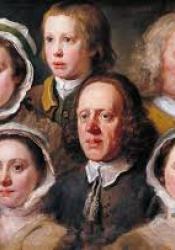Formal Realism and the Novel: Watt's outline of features
Whereas earlier periods had turned to universal, classical, traditional plots, which were retold and revamped by the artist, in the 18th-century, Defoe and others eshewed the traditional and classical and instead situated their plots within the everyday, oridinary lives of invididuals.
Thus, "before the novel could embody the individual apprehension of reality as freely as the method of Descartes and Locke allowed their thought to spring from the immediate facts of consciousness, . . . the plot and the scene of their actions had to be placed in a new literary perspective: the plot had to be acted out by particular people in particular circumstances, rather than, as had been common in the past, by general human types against a background primarily determined by the appropriate literary convention." (Watt 15)
Characterization (p. 18-19): Importance of particular names, realistic thought processes, represented as "particular individuals in their contemporary environment" (19),
Setting: As opposed to timeless settings of classical art, the novel sets characters against "a background of a particularised time and place."
"At his best, [Defoe] convinces us completely that his narrative is occurring at a particular place and at a particular time, and our memory of his novels consists largely of these vividly realised moments in the lives of his characters, moments which are loosely strung together to form a convincing biographical perspective. We have a sense of personal identity subsisting through duration and yet being changed by the flow of experience."(21
Place: "the pursuit of verisimilitude led Defoe, Richardson and Fielding to initiate that power of ‘putting man wholly into his physical setting’ [36] which constitutes for Allen Tate the distinctive capacity of the novel form; and the considerable extent to which they succeeded is not the least of the factors which differentiate them from previous writers of fiction and which explain their importance in the tradition of the new form." (Watt 27)
Linguistic: Whereas "previous stylistic tradition for fiction was not primarily concerned with the correspondence of words to things, but rather with the extrinsic beauties which could be bestowed upon description and action by the use of rhetoric, "(28) the novel sought first and foremost language that gave an "air of complete authenticity" to the realism of the scenes, characters, and events; they are depicted with "closeness and immediacy" ( 27).
The goal of the 18th-century novelist was to employ language that would " bring his [or her] object home to us in all its concrete particularity, whatever the cost in repetition or parenthesis or verbosity" (29)

